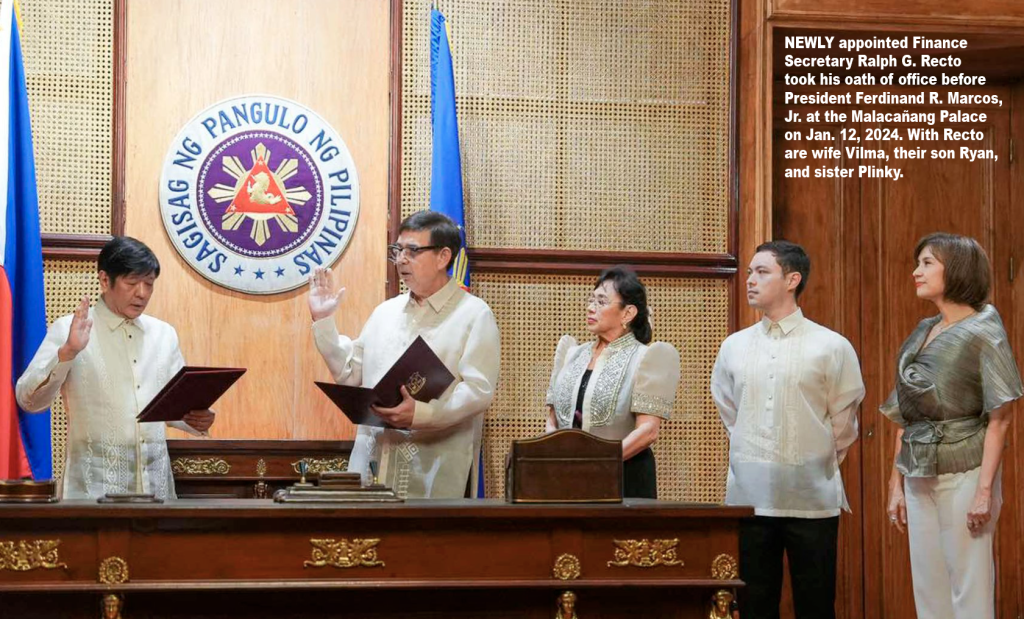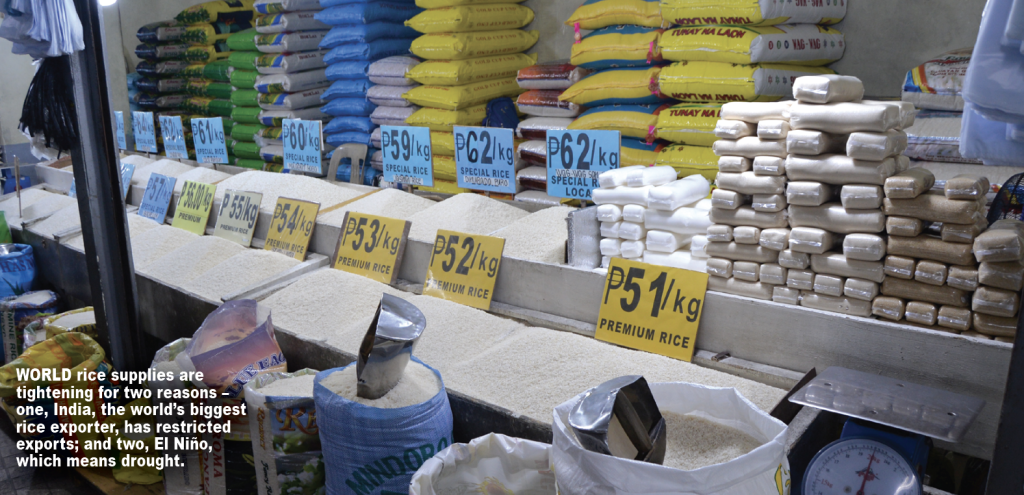Food shortages, joblessness, and tension in South China Sea
By Antonio S. Lopez

Filipinos are in the grip of three major crises: a food shortage, joblessness, and the West Philippine Sea tension.
The food shortage is a quarter of people’s food needs. More than 20 million have no jobs. And the standoff at the South China Sea could draw the major military powers, the United States and China, into a geopolitical rivalry whose outcome could be dire and unpredictable.
To cope with the first two, President Ferdinand Marcos Jr. has deployed technocrats to handle the economy – Ralph Recto, 60, as Finance secretary and Frederick D. Go, 55, as secretary for Investment and Economic Affairs.
There are 35 million jobless Filipinos.
Ralph and Deck have spent 30 years each in their fields to reach the top and make an indelible mark. Ralph was the youngest congressman when he joined the House of Representatives where he served for 11 years, rising to No. 2 as a deputy speaker. He was senator for 18 years (rising to No. 2 as Senate President Pro Tempore). Ralph was also President Gloria Arroyo’s economic planning secretary for one year.
A leading tax legislator
“No other legislator, past or present, has spent more years in Congress legislating tax laws than Secretary Recto. He knows what is proper in principle and pragmatic in practice,” says Albay Rep. Joey Salceda.
Ralph knows the boldness of legislation in its fine print. He knows crisis when he sees one.
When he entered Congress, he recalls, “in many places, when you opened the taps, there was no water. You tried to catch a plane, there was none. You lifted the phone, you got a busy signal. You switched on the lights, there was no power.” He helped solve those problems.
In 31 years, Frederick built from scratch 54 shopping malls, 31 office buildings, 28 hotels and resorts, six industrial facilities, and 19 mixed-use developments.

Teodoro on WPS
In response to the WPS issue, BBM has tapped 1989 bar topnotcher and Harvard-educated (Master of Laws) lawyer Gilberto C. Teodoro Jr., as secretary of Defense. He is also a technocrat. Gibo’s strategy so far is to be belligerent towards China, the intruder into the South China Sea territorial and sovereign rights claims of the Philippines, and to boost the country’s naval weaponry. Teodoro says Beijing aims to convert the South China Sea “into a lake of China”, using its so-called swarming strategy.
China is trying to unilaterally amend the 1982 United Nations Convention on the Law of the Sea or UNCLOS and other international laws “by letting other countries submit to its unilateral claim of the whole of the South China Sea as its internal waters,” the Defense chief points out. “It is using coast guard vessels which are massive — equivalent to naval vessels, too — to enforce domestic and criminal Chinese law in the whole of the South China Sea.”

Swarming tactic
Teodoro bristles at China’s swarming tactic “to unilaterally pound into submission other countries” to accept their “definition of what international law is with respect to the law of the sea.”
The Manila Overseas Press Club hosts Secretary Gibo as speaker during the MOPC Defense Night on Jan. 23, 2024 at the Fairmont Hotel Ballroom. Those who want to hear him, please contact MOPC’s Miss Dena, 0920-204-9229 or email this columnist.
China has now the largest navy in the world, with 348 ships; the US has only 296. It is also the world’s second largest air force.

Reports the Market Research Future: “China has the second largest air force in the world after the United States, which has the most significant air force strength. According to reports, the U.S. operates 10,000 more air platforms than China. In the total aircraft strength, is listed as serving 3,260 aircraft, whereas the US, 13,233 aircraft.”
“China aims to achieve Global Domination by 2049 by pursuing large-scale military modernization and force-size expansion, science and technology, and advances in new weapons areas such as hypersonic, as per the data. China lacks tankers when compared to the U.S., where the U.S. Air Force tanker has 625 aircraft, and China has only three tankers. Regarding helicopters, reports state that China has only 902 helicopters, whereas the U.S. has a 5,400-plus helicopter fleet.”
“China now operates the world’s largest Navy with an active-duty combat force of more than 2 million people, twice the size of the US.”
Lack of investments
The underlying problem with the food shortage, joblessness, and the WPS tension is lack of investments – in adequate food production, in business infrastructure (roads and IT connectivity), and in our defense infrastructure (gunboats and tracking technology).
That lack is exacerbated by another serious lack – lack of enough money.
When you are in government, the lack of money is called inadequate taxation. Or not enough tax collection.
Recto’s job No. 1 then is collect more taxes. In this country, tax avoidance (which is legal) and tax evasion (illegal) have become an art.
Philippine tax effort
The Philippine tax effort as a percent of the Gross Domestic Product (GDP) is 14.1%. The ideal should be 20%, the average tax-to-GDP ratio of our more prosperous neighbors. Our tax deficit is thus 6% of GDP. If GDP is P22 trillion, 6% is P1.32 trillion. That’s big money—enough to meet our total rice shortage over the next ten years, or build twice the number of road kms we need to build in a year. Or buy 16 Robinsons Land companies. RLC has market cap of P79 billion.
As Ralph himself points out: “We need funds to finance growth and our people’s growing needs, and install a system that promotes fair and fast tax administration. These measures will not only finance development but will reduce deficit and our dependency on debt.”
Overall, the newly minted Finance chief says:
“My job description is not just written in law, but dictated by economic conditions, shaped by what the people want, and directed by the nation’s development plan. And all of these are distilled into one objective: To promote growth that all of our people can benefit from, that results in the improvement of their lives, and secures the future of generations to come.”

Go: Not enough investments
For Frederick Go, lack of money is not enough investments, local and foreign (foreign direct investments or FDI).
That lack is blamed on two things –a restrictive economy (hence, the need to open it up thru charter change), and red tape (hence, the need to simplify doing business rules).
In 2022 alone, among the major countries of ASEAN, the Philippines received the smallest FDI, $9.36 billion. Singapore got the lion’s share, $141.18 billion; and far behind are: Indonesia $22.22 billion; Vietnam $17.89 billion; Malaysia $17.06 billion; and Thailand, $11.2 billion.
Frederick Go’s vision
President Marcos Jr. says of Go: “He has a vision of innovation, and Secretary Go will help us create an environment that will not just draw in investments but realize them, ushering in an era of unprecedented growth across industries.”
The President points out: “Many of these investments are going to be fully in the private sector, they can be PPPs, they can be joint ventures, Maharlika Investment Fund might also be involved. So, his expertise lies exactly there in creating an environment that is interchangeable between government and the private sector so as to be able to make these investments real, to make them profitable, and to make them be felt in the everyday lives of ordinary Filipinos.”
In 1921, Go raised $471 million from largest real estate investment trust (REIT) share sale ever by a Philippine company, that of Robinsons Land.
Food shortage: 25% of needs
A quarter of our food needs cannot be met by local production. The response has been massive food importation—thru legal imports and thru smuggling.
In rice alone, the Philippines needs to import 3.5 million tons yearly. At $600 per ton, 3.5 million tons is $2.28 billion. That’s conservative.
World rice supplies are tightening for two reasons – one, India, the world’s biggest rice exporter, has restricted exports; and two, El Niño, which means drought.
Philippine rice production is dependent on water – from irrigation and rainfall. Rainfall is equivalent to one harvest season, or up to a third of a farmer’s palay output.

Unemployment rate lowest
The government claims the lowest unemployment rate – 3.6% in November 2023, or an unbelievable only 1.8 million people jobless. Government defines an employed person as an adult (above 15) and one has worked for at least one hour in the past three weeks when government conducted the survey.
So if you have no work and your mom sends you on an errand, to be paid with a tip, to buy patis, or vinegar or detergent, or a kilo of rice at a nearby store and it took you one hour because of traffic, you are considered employed. You have lowered unemployment.
35 million are actually jobless
There are effectively 35.33 million jobless Filipinos.
They include the 27.28 million (34.1% of a total labor force of 80 million, those are who are 15 and above) who the government says are not part of the labor force because they are not looking for work, the 6.16 million who are underemployed (they don’t like their job, they are underpaid for their qualifications), and the 1.89 million who the government claims should be the only ones officially considered jobless.
The government has this fancy term called labor force participation rate—65.9% of a labor force of 80 million, or 52.72 million. About 27.28 million who are said to be not looking for work, so they are excluded from the 80 million labor force. The 52.42 million people are what you call the labor force participants; hence, a labor force participation rate of 65.9%.
